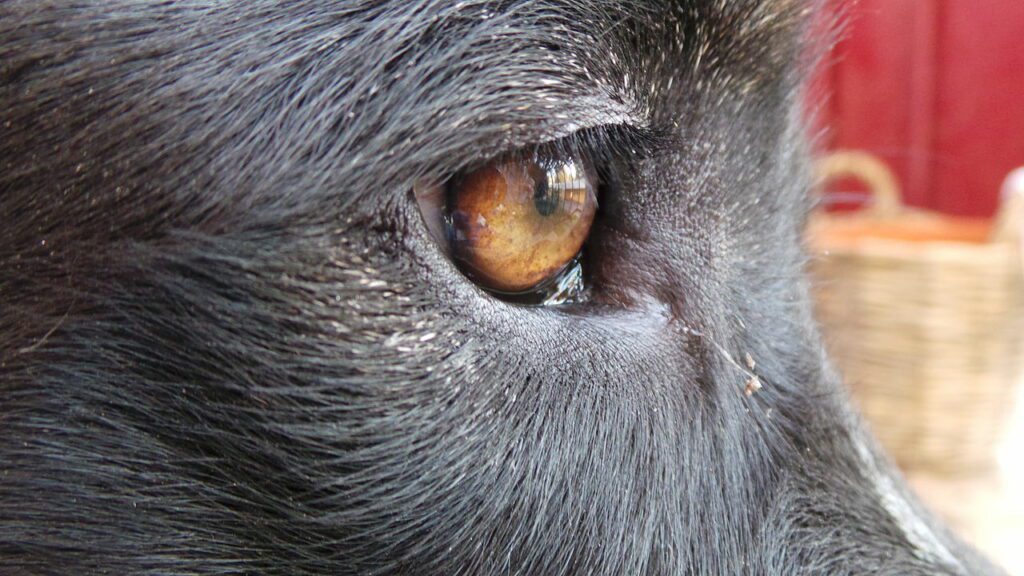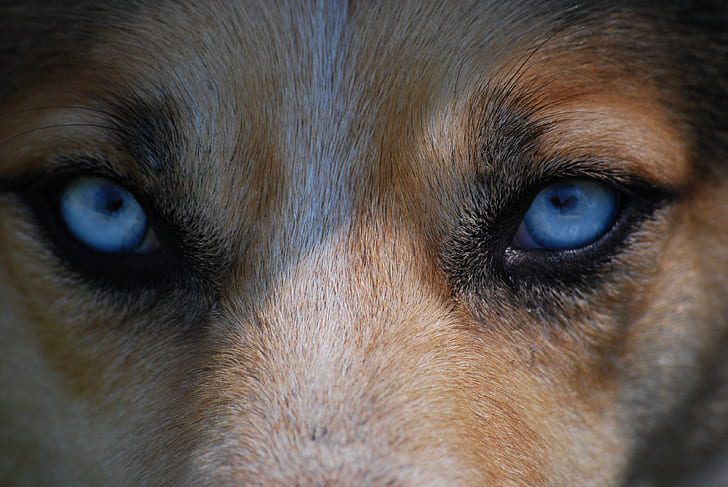When we think about dogs and their abilities, one aspect that often fascinates us is their vision. How far can dogs see? The answer is quite intriguing.
While dogs do not have the same range of vision as humans in terms of clarity, they possess unique visual capabilities that are well-suited to their lifestyle.
- Key Takeaway
- How Far Can Dogs See?
- Do Dogs Have Good Eyesight?
- How Dogs See The World
- What Colors Can a Dog See?
- How Far Can a Dog See In The Dark?
- Do Dogs See Better Than Humans at Night?
- What Does a Dog’s Vision Look Like?
- How Much Farther Can Dogs See Than Humans?
- How To Test Your Dog’s Vision at Home?
- FAQs
- Q: What can dogs detect with their vision?
- Q: Do dogs have night vision?
- Q: How far can dogs see at night?
- Q: What is visual acuity?
- Q: Can dogs see in color?
- Q: What is the field of vision for dogs compared to humans?
- Q: What are cones and rods in a dog’s eyes?
- Q: Can dogs see as well as humans?
- Q: Do dogs see the world in shades of gray?
- In Conclusion
Key Takeaway
- While dogs’ visual acuity is limited to seeing objects clearly at 20 feet that humans can see at 75 feet, their superior ability to detect motion up to 900 meters away and unique color spectrum interpretation offers them an effective way to navigate their environment.
- Dogs, with their dichromatic vision, rod-dominated retinas for superior night and motion visibility, and a wider field of view for depth perception, experience the world in a unique spectrum of blue and yellow, tailored to their evolutionary needs.
- Dogs, with their dichromatic vision, perceive the world in shades of blue, yellow, and gray and excel in detecting movement, but struggle to see colors like red, green, pink, purple, and orange.
How Far Can Dogs See?

Scientific testing reveals that dogs have a visual acuity of only 20/75 which means dogs can see an object 20 feet away and humans can clearly see the object from 75 feet away.
However, dogs excel in detecting motion. A study involving police dogs found that the most sensitive dogs could recognize a moving object from as far away as 900 meters.
So, while dogs may not see long distances as clearly as humans, their ability to detect motion and their unique color spectrum provide them with a different, yet effective, way of interpreting the world around them.
Do Dogs Have Good Eyesight?

Yes, dogs have good eyesight. Canines can see better in low light than humans, but their overall vision is much worse when it comes to color and detail.
Dogs can also detect motion quicker than humans, enabling them to spot small prey or potential danger from far away.
However, dogs are nearsighted and will struggle to identify objects at a distance of more than 20 feet or so.
How Dogs See The World
Dogs perceive the world in a unique way because their vision, while not as colorful as ours, is adapted to their needs and evolutionary history.
Canines are dichromatic, meaning they have two types of cones in their eyes, allowing them to see in a spectrum of blue and yellow.
Furthermore, dogs have rod-dominated retinas that enable them to see well in the dark and have better motion visibility than humans.
They also have a wider field of view than humans, which helps them perceive depth.
What Colors Can a Dog See?
Dogs have only two types of cones in their eyes, which allow them to see blue and yellow colors. This means they can’t perceive red, green, and shades containing these colors like pink, purple, and orange.
Despite this limitation, dogs have a distinct advantage in seeing various shades of gray and detecting movement. Colors such as indigo and purple appear blue to them. The hardest color for dogs to see is red.
Contrary to popular belief, dogs don’t see the world in black and white. Instead, they see a range of blues, yellows, and grays, providing them with a different, yet effective, visual experience of the world.
How Far Can a Dog See In The Dark?
The typical range for a dog’s nighttime visibility is approximately 200 feet; however, some breeds may be able to see slightly farther than this due to their particular eye structures.
Dogs have good vision at night because they have a larger number of rods, which are specialized cells that help them to detect motion and dim light.
While dogs may not be able to make out fine details in the dark as well as they can during the day, they can still spot movement and use their sense of smell to gain more information about what lies ahead.
Do Dogs See Better Than Humans at Night?
Yes, dogs see better than humans at night because they have a tapetum lucidum, which is a layer of cells in their eyes that reflects light back into the eye and increases their vision in low-light conditions.
Additionally, dogs also have larger pupils than humans which allows them to let more light into their eyes and makes it easier for them to see at night.
Furthermore, dogs also have more rods in their eyes than humans do, which helps them detect movement even when there is dim lighting.
This combination of features allows dogs to see much better than humans can at night.
What Does a Dog’s Vision Look Like?
A dog’s vision is similar to a person with red-green color blindness. Dogs are not completely color blind, however; they can see blues and yellows, but not reds, greens, or oranges.
Additionally, dogs have more rods in their eyes than humans do which means they are better able to detect motion and see in lower light levels.
Their visual acuity (ability to discern details) is also poorer than a human’s due to the size of the dog’s retina.
As a result, dogs may appear to be nearsighted because objects that are far away seem blurry and out of focus.
However, when something close catches their attention they can quickly focus on it and respond accordingly.
How Much Farther Can Dogs See Than Humans?
Dogs have a wider field of vision that spans around 250 degrees, compared to the 180-degree range of human vision.
They also possess better night vision and are able to detect movement from further distances.
This gives them an edge when it comes to spotting prey or potential danger from afar, making them better hunters and protectors.
Additionally, their eyes contain more rods than our own, which allow them to see in dim light and pick up on subtle movements that would escape our notice.
How To Test Your Dog’s Vision at Home?
- Menace Response Test: This test involves using your hand to check your dog’s reaction. Start by holding your open hand about a foot or 18 inches away from your dog’s face. Then, move your hand swiftly toward its face until it’s about 3 inches away. Your dog should blink or flinch in response. If there’s no reaction, you may want to test each eye separately to see if there’s an issue with only one eye.
- Cotton Ball Test: This test requires a cotton ball and a well-lit space. Cover one of the dog’s eyes and drop a cotton ball about six inches away from the dog. If the dog follows the cotton ball with its eye or head, this could indicate that its vision is intact. Repeat the test for the other eye.
- Movement Detection: Dogs should be able to detect movement. You can test this by moving an object or your hand across your dog’s field of vision to see if it tracks the movement.
- Obstacle Course: Set up a simple obstacle course using furniture and observe how your dog navigates it. Changes in behavior that indicate confusion, dizziness, or bumping into objects may suggest vision problems.
- Light Sensitivity: Check if your dog is squinting or seems sensitive to light. This could be a sign of eye discomfort or vision issues.
FAQs
Q: What can dogs detect with their vision?
A: Dogs can detect motion and see objects that are 20 feet away.
Q: Do dogs have night vision?
A: Yes, dogs have night vision. They can see in dim light much better than humans.
Q: How far can dogs see at night?
A: Dogs can see up to about 75 feet away in the dark.
Q: What is visual acuity?
A: Visual acuity refers to the sharpness and clarity of vision. Dogs generally have better visual acuity than humans.
Q: Can dogs see in color?
A: Dogs are not completely color blind, but they can only see two colors – blue and yellow.
Q: What is the field of vision for dogs compared to humans?
A: Dogs have a wider field of vision than humans, allowing them to see objects from a wider angle.
Q: What are cones and rods in a dog’s eyes?
A: Cones and rods are cells in a dog’s retina that are responsible for detecting light. Cones are responsible for color vision, while rods are more sensitive to dim light.
Q: Can dogs see as well as humans?
A: Dogs do not have the same level of visual acuity as humans, but their other senses like smell and hearing make up for it.
Q: Do dogs see the world in shades of gray?
A: It is a popular myth that dogs see the world in black and white. Dogs can actually see some colors, but not as many as humans.
In Conclusion
In summary, while dogs may not be able to see as far as humans in terms of clear, detailed vision, their ability to see in dim light, detect motion at greater distances, and perceive certain colors makes their vision remarkably effective for their needs and lifestyle.





Leave a Reply